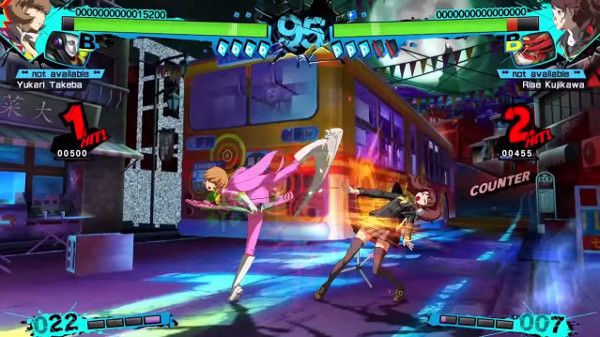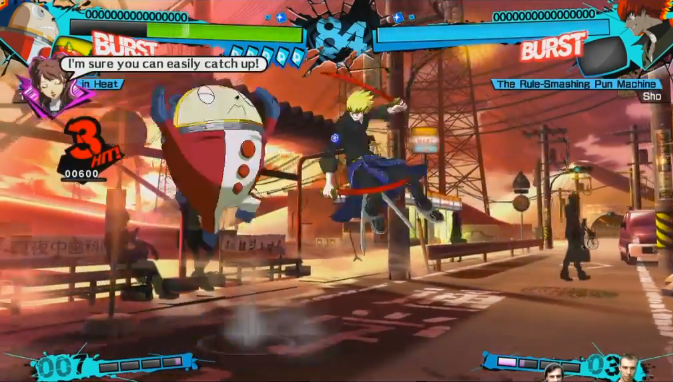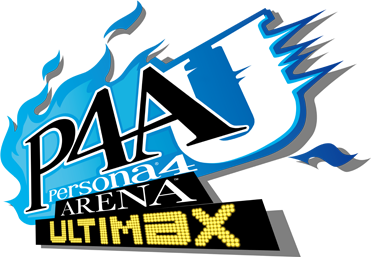- Format: PS3 (version reviewed), 360
- Unleashed: Out Now
- Publisher: SEGA
- Developer: Arc System Works/Atlus
- Players: 1-2 (offline & online)
- Site: http://www.atlus.com/p4au/eupurchase.html
- Game code provided by the publisher
When the first Persona 4 Arena was announced, it seemed like a bad idea (at best) or an extremely cynical one (at worst). A beat ’em up sequel to an extremely-story-heavy turn based RPG? That’s just crazy talk! But you know what? It was excellent on just about every possible level. It must have been more of a success than you’d expect, as there’s now a sequel on the shelves and it, too, is extremely good; but who it is extremely good for is another matter entirely.
The development setup is pure genius. The actual fighting part of the games is developed by the people behind the utterly gorgeous, surprisingly deep, and ineffably enchanting Blazblue series. The story art and script on the other hand are handed to the Persona team, with the original P4 actors drafted in wherever possible. The unique result is a single continuous, chronological story that starts with an RPG and follows immediately through two one-on-one fighters. Both P4As have several hours of story, and Persona 4 Arena Ultimax even lets you skip the fights in story mode. And yes, there will be many people who will gladly take advantage of this feature.
That has absolutely nothing to do with the quality of the fighting system. In truth, P4A takes the Blazblue template, and then tweaks it only slightly before adding huge dollops of Persona flavouring. This is no bad thing. Explaining all the intricacies of combat would take far longer than we have here, but we can at least confirm that the tutorial does an extremely good job of making things user-friendly. The basics run thus: Control inputs for special moves are more Street Fighter than Mortal Kombat, and characters attack through both a held weapon and their ‘Persona’, a guardian who appears briefly on-screen for the duration of the relevant attack. It’s possible to ‘break’ a Persona by hitting it in the middle of an attack however, making it temporarily impossible for your opponent to use it. This then suddenly limits their available moves and techniques.

Don’t be fooled; this is so much more than another set of anime schoolkids fighting one another.
As is the fashion nowadays there’s a gauge, filled by attacking and being attacked, to keep an eye on. You can use varying portions of this to unleash a more powerful attack, rescue yourself from a tight corner, or even summon a powerful one-hit-kill attack where winning the round means winning the fight. Although we’ve not touched on many elements it might already sound like there’s a lot to learn, and there is; but the uninitiated are well catered for. Not only is there the aforementioned tutorial, there’s also the obligatory training mode and – for when you’re trying it out for real – each character has one combo which can be auto-triggered by successfully landing a series of hits with just one button.
All this means that if you want to ignore the Persona license entirely, you’ll still find an excellent, demanding, rewarding beat ’em up to sink your teeth into. Be warned, however; if you’re prepared to put anything less than complete dedication of time and effort into learning every nook and cranny of the controls, online matches are likely to bring you nothing but pain and misery. Finding an opponent to begin with brings its own challenges, as the servers are disappointingly barren. At least half of the players that you do find will be of a terrifyingly high level (though if you’re good enough to defeat them, the XP rewards are huge). A great many of those at the lower end of the scale rely on very cheap combos and techniques, which you’ll need a good understanding of the system to avoid (or at least, limit the effectiveness of).
Speaking of cheap moves, the worst offender in this respect is Adachi, which is why he is so often the character of choice for the most annoying people to play against. The reason this grates is that Adachi is paid-for DLC. The reason this grates even more is that, while he was ready at launch but was available for free in the first week for the US, use of him demanded cash from day one in the UK/EU. The reason this grates yet more is that, as fans are well aware, Adachi is a recurring and important character in the original Persona 4 story.

Fans will be pleased/horrified to learn that Teddie still uses dozens of bear puns.
P4A ended on a cliffhanger, and P4AU follows on immediately. Know ye this: full understanding of the story requires you to have played through not just Persona 4 Arena, but also Persona 3 and Persona 4. The less you’ve played, the more you’ll wonder what the hell’s going on here. For those in the know however, this time round the shenanigans have more in common with the events of Persona 3, and as a result Ken, Junpei and Yukari (as well as Rise and a brand new character) join the playable character roster. Overall we’d say things aren’t quite so consistently interesting as the prequel, but the story alone makes this game well worth the money for people seeking closure to the extended Persona 4 tale.
Back in the land of interactivity, other things going on offline are an Arcade mode for traditionalists, and the all new Golden Arena Mode. This basically sets you up against a long series of opponents (progress is saved at set intervals) at three different difficulty levels. Each character you use is levelled up individually with points you assign to attack, defence etc. It takes a while to present any real challenge, but can become something of a time sink when it does.
The story is all-new, but many elements – including most characters and their attacks – are near-identical to the last game. It should go without saying that Persona nuts will devour this for many hours, in terms of the story at the very least. If you have no knowledge of or interest in Persona, this is still a brilliant fighter well worth your money; but think twice if you already own the prequel.









Comments